2016.07.30

The Great East Japan Earthquake – What happened until we moved into temporary housing
Foreword
Despite the fact that over 4 years have passed since the disaster, I have received more feedback to my last article, “The Great East Japan Earthquake – What happened at the evacuation shelter in the gymnasium”, than I could have imagined.
I got many comments like “it made me think” and “I will try to speak to my family”, many people addressed disaster prevention and reduction, and I was glad to realize that this issue has not faded into the background as much as I thought it had. I believe that familial education is the basis of disaster prevention. Being prepared, protecting oneself, evacuating, preventing a second disaster. Instead of teaching it at school in a short period of time, with this kind of knowledge we will be more successful if it is taught at home and repeated to our children and grandchildren until it is “imprinted”.
Even though we use this single term “disaster prevention”, different types of disasters call for different measures. There are some, like earthquakes, for which we are currently not scientifically capable of making detailed forecasts, and there are others, such as typhoons, rainstorms, and snowstorms, for which we can very well make predictable forecasts to some extent. Fleeing from a tsunami, volcano eruption, or rain storm is effective. Fleeing from a heavy rainstorm or snowstorm in the middle of the night is dangerous. There is not one valid solution for every kind of disaster.
I want people to get their hands on as much information as possible, just in case. There are lots of people like me, who are providing insights into the circumstances and measures of past disasters, as well as experts and specialists, so please try to search for and read materials about not only earthquakes but also other types of disasters.
Once again, I will tell you about the occurrences at the evacuation shelter inside the Yonesaki Elementary School gymnasium. Last time, I wrote mostly about the disaster itself and about our first evacuation shelter. This time, I want to elaborate on what kind of trouble we ran into after evacuating. Additionally, I will tell you about what happened until we moved from the evacuation shelter into temporary housing. I hope this will serve as a useful reference for the development of a future evacuation shelter operation manual and that it will trigger discussions about disaster prevention and reduction in every home.
However, this record is only one example of evacuation shelter management, not necessarily the best. Please remember that troubles may arise that didn’t occur in this particular evacuation shelter. Furthermore, I personally did not come up with everything referenced here. It is the result of consultations with those who took over the role of management officials for us, their feelings and thoughts.
How did we create a livable environment?
<Making beds with gym and straw mats>
Compared to the junior high school gymnasium, Yonesaki Elementary School’s gymnasium was slightly smaller in size. To help you imagine it: Although lines were drawn for two adjacent volleyball courts, standing in the serving position you could touch the wall with your hand. On March 12, over 300 people slept on the floor space available here.
Because Yonesaki Elementary School hadn’t originally been set up as an evacuation shelter, it had no supply storehouse. However, after seeking advice from the school’s deputy principal, who was sleeping here because his house had been washed away, we were able to borrow the school’s supplies. Additionally, we received permission to bring the judo and gym mats, potbelly stoves, and other useful items over from the junior high school to which we had evacuated on the first day.
We used gym mats and the straw mats, which were originally used by the senior society for local events, to cover the floor and, even though it was tight, nearly no one had to spend the night directly on the floor. Because the school’s fifth and sixth-year students play the drums, we had about 20 blankets intended for storing and transporting the instruments to use while sleeping and to keep us warm.
The elementary school also had kerosene stoves that could be used without electricity, as well as a stock of three to four 18-liter fuel containers. Unfortunately, inside the high-ceilinged gymnasium, all the heat rose to the top and it was impossible to properly warm the room. Nevertheless, we were able to warm our frozen fingers. By filling kettles and metal tubs with water and placing them on the stoves we kept the air from getting dry and were able to prepare hot water for cooking.
We had created a place for ourselves that would shelter us from both rain and wind, but of course, we had no electricity, no radio or cell phone signal, no information, and no home we could return to.
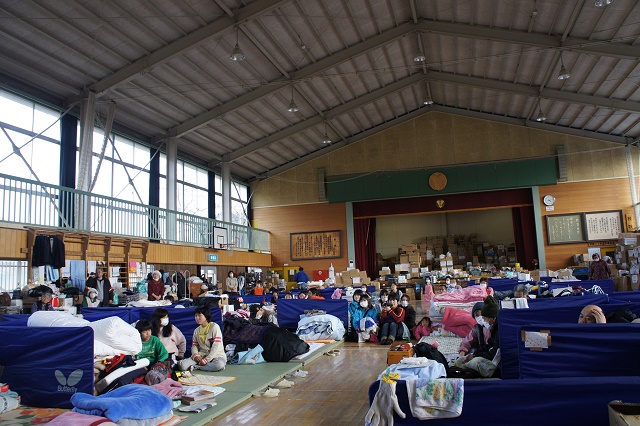
<From ‘shoes on’ to ‘shoes off’>
The Great East Japan Earthquake with its 9.0 magnitude and max seismic intensity of 7 (Japanese scale) is firmly etched into our memories.
But besides that, aftershocks with a seismic intensity of 5 and more also struck continually, one right after the other. What was especially frightening at the Yonesaki Elementary School evacuation shelter, was being inside during the aftershocks and experiencing how the gymnasium would shake. We were fighting the constant feeling of dread that the structure would collapse or the large windows in the ceiling would break and fall down onto our heads.
For this reason, we made sure that, even if the windows did break, we could always evacuate from all of the gymnasiums exits and lived with our shoes on.
However, sleeping and eating in a dusty, dirty space isn’t healthy. Making use of the knowledge of our nurses, we started sleeping in the masks that arrived with the relief supplies, to protect our throats from the dust and the cold. But to those who weren’t used to sleeping in a mask, this caused great distress. After two to three nights, most people were sleeping without a mask.
Thankfully, about a week after the disaster happened, the aftershocks lessened, and on the tenth day we declared a ‘shoes off’ policy inside the gymnasium. In addition, we rearranged the spaces for each household and created partitions area by area. This way we were keeping an eye on making sure everyone stayed as healthy as possible.
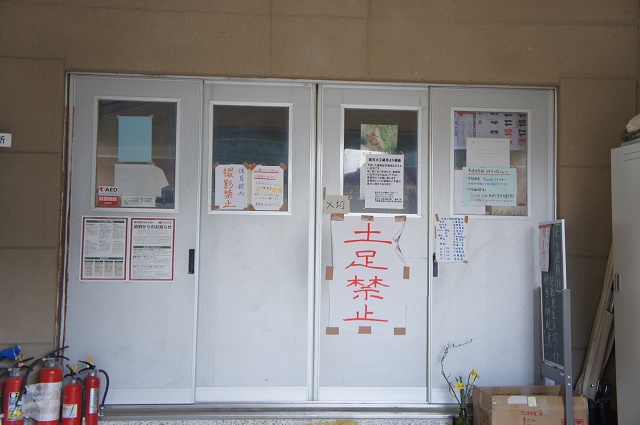
<Medical care>
For medical treatments and health monitoring, we received regular visits from teams sent by the Japanese Red Cross Society as well as the Iwate Medical Association.
But just after the disaster occurred, there was no radio or cell phone signal and no one was able to even call an ambulance. To deal with this (I don’t know the exact order of occurrences), a special road was cleared from the Ofunato highway down towards Ofunato Hospital exclusively for medical emergency vehicles, cars that disaster victims offered up for transporting people in need.
This way they were able to reach all of the evacuation shelters. Cars were registered with each shelter, a paper that read “emergency vehicle” was pasted onto the front, and we were allowed to use them whenever a person suddenly fell ill. Especially because numerous people were at the Yonesaki Elementary School evacuation shelter, who required dialysis, the opening of this emergency route was a big relief.
<The cooking area>
At first, we were preparing our meals in the kitchen of the nearby preschool. We did this because the walls of the school building that housed the elementary school’s kitchen had cracked, which caused safety concerns regarding the gas pipes. However, we received notice that the preschool was scheduled to reopen in April and that we needed to vacate it by April 10. Which meant that we weren’t able to use the kitchen anymore.
We thought that we might be able to use the elementary school’s kitchen if it were repaired, but of course, the school would reopen sooner or later as well. Besides, the kitchen was in the school building farthest away from the gymnasium and there was a great chance that we would make a mess transporting the food, so we decided to think of a different solution.
That’s when we decided to build our own kitchen with wood that had been washed up by the tsunami, canvas that had arrived with the relief supplies, and a soccer goal as a foundation structure. After carrying up a long sink typically used for various events, which had been stored behind an official’s home, our kitchen built from scratch was finished.
On April 11, although it was weak, I finally got a cell phone signal on my mobile. Right in that moment, I received a phone call from the president of the company I used to work for (in Yonezawa, Yamagata). He sent me a large pot, a gas cooker on which it would fit, several cutting boards, and knives. Thanks to his generosity we were able to cook food for our large number of people.
<Crime watch>
About half a month after the disaster, we weren’t able to get our hands on either gasoline, diesel fuel, or kerosene. Broken and washed up cars were toppled over all over the place, many of their gas tanks had been broken open and the fuel taken out. This is how desperate people were for fuel. Since this was a time of disaster, I don’t know if you could call this a crime. Fuel was also taken from the cars that were parked by the elementary school.
Here is another example.
During the fire brigade’s search and rescue activities drum cans became half visible in the debris. This was in the fishing district. Fuel on the fishing boats was usually stored in drum cans, so they had obviously been washed ashore. Inside them was diesel fuel and they even had their owner’s name written on them. We contacted the owner, received his permission to take them, and placed them close to the entrance to the evacuation shelter. Some of it, we gave to the builders and contractors, who were working on clearing the roads, some we filled into an evacuee’s diesel car.
But someone stole diesel fuel from these drum cans we had placed close to the evacuation shelter’s entrance. They took something in secret that we would have gladly given them if they had asked. It is a sad reality. I don’t know who the culprit was. What I find frightening is diesel fuel and gasoline being collected by amateurs. There’s also the danger of a fire breaking out.
After this happened, we began patrolling the area around the gymnasium every night, the parking lot, even all the way to the main school building. First, we thought we would decide who would be on duty with everyone in the shelter, but some officials worried that by determining duty roles this way, security information may be leaked. In the end, I and a few friends I asked to help me out went out on patrolling duty in a small group.
We did let the people in the evacuation shelter know that we would be patrolling every night, but didn’t tell them our schedule and carried out this activity at varying times. After this, no more fuel was stolen again, but we continued patrolling every night until the end of April.
The appointment of management officials
By order of one of my superiors in the fire brigade, I received the role of a management official. Immediately, I thought up ways to not have to take care of every single duty by myself.
Reception, greetings and thank-yous, management and distribution of supplies, evacuation shelter management decisions and announcements, preparing and giving out meals as well as washing the dishes, seeking ways to improve the living conditions, tending to sick people, fiscal matters – these and many more are the daily tasks that arise during life in an evacuation shelter. I knew that I needed help.
I needed to rely on other management officials, but it would be hard work and whoever I asked might refuse the position.
Luckily, there were many who had taken leadership positions during festivals. When you are involved in the management of festivals, you build relationships with the people from your community.
You even become acquaintances with people involved in neighboring festivals, learn their character, occupation, and what they are especially good at. I knew that even here I could count on the people, who had served as leaders at local festivals. The roles that need to be filled in an evacuation shelter are not so different from roles that are important at festivals.
When I approached the people I had chosen to be officials with the words “please become a management official,” they first thought about it for a second, but all agreed. Now there were 10 people working under our head of management and I was in charge of general affairs. Given the overall anxiety, it might be helpful to appoint officials as quickly as possible.
The people moving around the shelter weren’t only disaster victims and management officials. Experts and professionals like carpenters, nurses took over in fields where they could apply their skills, but there were many other tasks that needed to be tackled, such as organizing relief supplies, preparing meals and giving them out, washing up dirty dishes, and making improvements to our living conditions.
Because letting the volunteers carry around your own and your family’s belongings is not acceptable either, everyone was chipping in and doing the best they could to help us out.
Another issue is the waste that accumulates while we live our everyday lives. Every morning, before the wind would pick up, we burned that trash, dividing it up between 10 cremators. (Because we are a rural community, we were able to burn our waste outdoors.) Thankfully, the least amount of awareness everyone had was that of “there must be something I can do, too.”
Even though I got stuck on issues here and there every day, I always kept two things in mind while working as a management official.
The first was this: Delaying a decision until tomorrow doesn’t help, it will just add to my load of issues. Instead of searching for the best solution until tomorrow, go for the second best that is possible at this moment, move now. But don’t make the exhausted and fatigued evacuees work too hard.
The second was to remember that I alone don’t have the capacity to help each and every one of the disaster victims. The thought I kept in the back of my mind was that “I need to make sure my children are safe and sound,” and whenever I couldn’t make up my mind about a certain decision, my children’s faces would appear before my eyes, then I would decide what to do.
The problem with supplies
<Supplies and their destinations>
Until about 2 weeks after the disaster, we didn’t have a functional mail delivery system. But once delivery became possible, it was impossible to figure out at which evacuation shelter the people were staying, whose houses had been washed away. From the day a package was sent out it took at least a week to reach the recipient.
Therefore, whenever people were sent perishable foods, their expiration dates had sometimes already passed or they had developed mold. (If it was only the expiration date that had already passed, the food was eaten anyway.)
Additionally, because information on the exact location of all evacuation shelters wasn’t readily available, we saw many kinds of addresses. “Evacuation shelter in Yonesaki district,” “elementary school evacuation shelter,” “gymnasium evacuation shelter” – these all reached the Yonesaki Elementary School evacuation shelter. We were often also asked by the delivery personnel to “please, take this too.” Thinking back on this now, I wonder if not a certain bias of support was at play here.
Rikuzentakata City Hall was also severely damaged, most public buildings were. Even though we received all these packages, it was difficult to sort and distribute them. In this Japanese earthquake disaster, Rikuzentakata experienced terrible disaster conditions. I believe it is important to establish a distribution method for relief supplies, keeping this kind of situation in mind.
<Thoughts while receiving supplies>
We received many supplies right after the disaster occurred. Because it took about 2 weeks until deliveries were possible, lots of the supplies were brought to us in the supporters’ cars.
Blankets, towels, and clothing were taking up a lot of space, but more came. We received food and water, there were even people who brought us vegetables from their own local fields. We were very grateful for the big amounts of other emergency foods, like cup noodles, which would keep for a long time.
People came with more than 10 white, 20-liter plastic water tanks because they imagined it would be hard to ensure a water supply for a large group of evacuees living in this place where there was no running water. We could distinguish them easily from the red kerosene tanks and knew they were safe to use.
One thing that was especially practical to use, was tough, twisted rope. Survival camp hobbyists brought us different kinds of rope with 7mmx200m, 9mmx200m, and 12mmx100m. They helped us out by also bringing scoops and scissors with which we could cut the sturdy rope.
We also received supplies that made us think about disaster prevention.
From an individual, we received over 10 bags with emergency kits, but more than half of them contained expired simple foods and water. Liquid had spilled over the electric lights, which were unusable. You can imagine that in a chance disaster, these bags were useless. When we took a look at the date of manufacture, most of them read 1995 and 2004. In other words, they had been purchased in the years of the Great Hanshin Earthquake and the Chūetsu Earthquake.
The problem with our approach toward disaster prevention and reduction is that people do a lot when something has happened and are then satisfied with their efforts. It looks to me like transience has become too widespread. In the wake of the Great East Japan Earthquake, certainly more people will be preparing an emergency kit. But please, check its contents at least once a year.
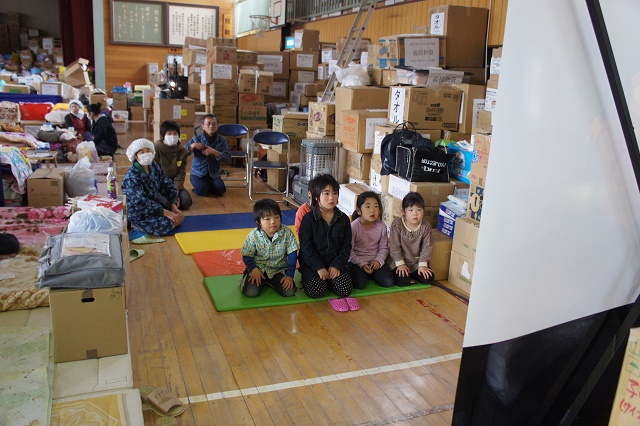
An evacuation shelter’s reception
Many different kinds of people come to an evacuation shelter’s reception. People looking for someone. People kindly bringing relief supplies. People doing consolation activities. The media. At the reception, we first ask what they came for, then connect them to the person responsible.
<Searching for someone>
The most common reason for someone to come to an evacuation shelter is because they are searching for someone. They come to look for their missing relatives. I can’t express in words the deep emotions we experience when they are able to reconnect with that person. Embracing each other, they pat each other’s backs and cry. There is no room for conversation.
Finally, they manage to squeeze out the words “thank goodness, you’re alive.” To them, these relatives have truly just crossed the border from death to life. This reunion is the result of a search of half believing and half doubting that they will find them. At our evacuation shelter’s reception, we experienced these emotional reunions numerous times in the first two and a half months.
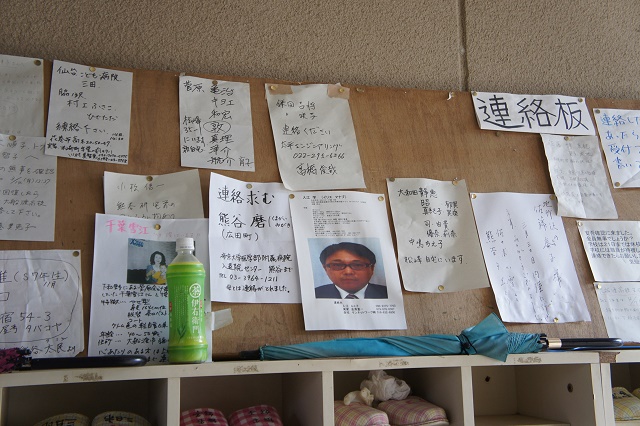
<Relief supplies>
In the event of someone bringing supplies, we would connect them to one of the people in charge of our relief supplies. As there are many different kinds of supplies, from living supplies like clothing and towels to plastic tanks of fuel or food, we also had many different people in charge of them.
While we waited until the person in charge came, we asked them to write down their name and address so we could write them a thank-you letter when we finally vacated the evacuation shelter. Many of them declined and I feel sorry about not being able to send them a few words of thanks.
Right after the disaster, we hadn’t thought of getting their names. Of course, there was a lot going on at the time, but we also simply couldn’t imagine us ever getting out of the evacuation shelter. The first time we were able to imagine life after the shelter was when we saw workers begin with the construction of temporary housing units next to the gymnasium.
After about a month, a strange phenomenon set in.
More and more supporters who came would say something like, “I brought blankets and other things, but I wonder if they might bother you.” When we asked them why they would assume such a modest attitude when they had come all the way here to help, we found out that they had been refused by several other evacuation shelters. Apparently, after a month the smaller evacuation shelters like community centers were running out of space to store supplies and were refusing to take any more in.
At Yonesaki Elementary School, we took in all supplies that were brought to us. We would divide the things we could use amongst us, and if anything was left over, we would carry it to the other shelters and let them take whatever they needed. Even though we received clothes that didn’t fit anybody in our shelter, when we went to the other evacuation shelters, we would find an especially tall or slim person who was grateful for them.
<Consolation activities>
When groups or individuals came to sing or perform for us, we would check the content before we let them begin. We even received visits from celebrities we had seen on TV.
I believe it is a good thing to brighten the dark mood of an evacuation shelter, but because we only had limited space, we couldn’t make all of the activities happen.
Because our evacuation shelter was in an elementary school, it was not just a few people who came imagining they would have a large floor to work with. But in reality, this was where the disaster victims lived and slept, meaning there was next to no space at all.
Furthermore, we also received proposals for activities with synthesizers and such, but because April 10 was the first day we actually got a stable power supply, we had no choice but to refuse offers like these before that.
<Media>
Numerous media representatives came to report on the evacuation shelter’s conditions. I thought, “How long are they going to do coverages like these?” I remember that two months after the Great Hanshin Earthquake occurred the Tokyo Subway Sarin Attack happened, and with it reports about the earthquake stopped.
We all carried this feeling of “when are people going to forget about us?” and actively took on coverage requests. However, not even a month later everyone at the evacuation shelter told me they were exhausted. When the cameras came they couldn’t lie down to rest. They couldn’t put on makeup or fix their hair, and facing the camera became stressful…
I deeply regret not noticing this even though the lives of the people who had had to evacuate were my top priority. After this, we decided to have reporters do their stories outside the gymnasium.
About the media
<The daily local newspaper>
We neither had electricity nor a radio or cell phone signal at the Yonesaki Elementary School evacuation shelter, but we did receive the area’s local newspaper, the Tōkai Shimpo, every day.
Daily, we were able to find out about survivors, their names and whereabouts, as well as the large number of names of those whose loss of life had been confirmed. The newspaper informed us of the situation in areas afflicted by the earthquake disaster, reported about the opening of temporary medical facilities, and about the nuclear disaster in Fukushima.
Even now I am amazed at the city officials and the Tōkai Shimpo reporters, who, despite being disaster victims themselves, brought us extensive amounts information every day.
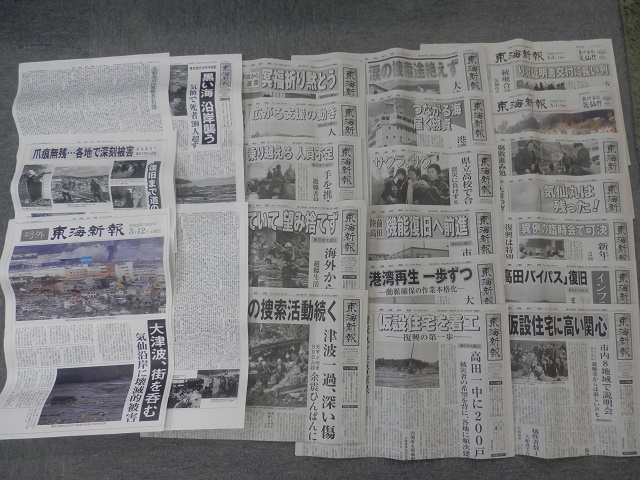
<Fake media>
Three days after the earthquake, it was not only the local newspaper that visited us but actually a lot of media reporters. News of our survival was picked up by a TV crew.
Because it would take too much time for each one of us to talk about our survival in our own words, the number of people who could be interviewed was limited. Instead, we were told that information about survivors and missing persons would be written on drawing paper, which we should hold up in front of our chests while they slowly filmed us lined up on a set of stairs. Writing this now, I can tell you that people we knew saw this report and knew that my family and I had survived.
Despite our worry that soon people would forget about us, we still received numerous visits from the media well after this report.
However, among them were also reporters with their own agenda.
In the beginning of April, we were honored with a visit from former Prime Minister Naoto Kan. At that time, a reporter came that was different from the ones who were doing coverage about the disaster area. This reporter asked us, “Don’t you think the Prime Minister is rather late in coming to see you?” Besides his use of the words “rather late”, this is a useless question.
Ignoring his obvious invitation to speak ill of the Prime Minister, I replied that “after the Great Hanshin Earthquake, news coverage was discontinued after only two months. I am grateful he is coming to see us.” But these were words the reporter couldn’t use.
Although I hadn’t even exchange one word with the former Prime Minister during his visit, I later learned that an article had been written stating that I had brought up issues with former Prime Minister Kan.
Management volunteers
One week after the disaster hit, with the help of volunteers the Rikuzentakata City Social Welfare Council established the ‘Rikuzentakata City Social Welfare Council Disaster Volunteer Center’, and we were sent volunteers, who would help us with evacuation shelter management.
They worked at the reception, carried, organized and distributed things for us, all things which we had been doing by ourselves. This was very helpful.
However, after about a week of this had passed, gradually problems started arising.
Daily rotating volunteers. Among them were some, who were a little too ambitious. Most of the people living in the evacuation shelter were very exhausted. But they would come in with lots of energy, belting out “OK, what are we doing today? Give me something to do! Let’s begin!” Some days all I wanted to tell them was “We don’t need you today, please let us rest.”
Furthermore, when we had them help us out at the reception, they wouldn’t know who of us to call when someone came with clothes, food, medical services. It took them time to remember the faces and names of the people in charge of different affairs at the evacuation shelter, and by the time they had memorized them it was time for a new volunteer to replace them. This process repeated itself constantly, and in the end, I was the one they always turned to about everything.
Finally, when I contacted the Disaster Volunteer Center and asked for volunteers who could stay longer than a week, they sent us volunteers who were planning on staying for more than a month and the problem was solved.
One of these volunteers also helped me with the management of the temporary housing units. Later, when I created the “Sakura Line 311” group, this person went on to work with me by becoming my executive director. Because they worked with us so long while always respecting our feelings and our timing, we were able to accomplish many things together.
Another person I would like to mention is the one who shared their photos with me for this article. At the time, there were many people who couldn’t accept different occurrences that were happening inside the evacuation shelter. I, too, was one of them. I couldn’t face the camera in such circumstances. But looking back on it now, these photos are a valuable record of our lives. I am so grateful to the volunteer, who took these photos.
Essentially, they were able to take these photos because they lived with us for so long and really understood what it means to be a disaster victim. If by any chance you happen to go to an evacuation shelter in the future, please don’t use the words “documentation is important” as a shield and avoid pointing the camera at evacuees without reflecting on their feelings. This point I want to strongly emphasize.
Posting on social networks
It was still weak, but exactly one month after the disaster, on April 11, the cell phone service provider AU’s signal returned. I wanted to somehow send out information, but the amount of data you can send with a mobile phone is limited.
I considered mixi (a Japanese social media platform), Facebook and Twitter, and eventually chose Twitter because of its comparatively low data usage. At this stage, I had no idea that my messages wouldn’t reach anyone as long as I had no followers. With this lack of knowledge, I began tweeting with the Twitter handle @kajyuon.
Let me tell you about something that happened on Twitter. On April 12 around noon, a house fire broke out in the district of Yonesaki. Even though the fire brigade was mobilized, the water supply wasn’t restored yet and the fire hydrants couldn’t be used. We decided to draw water from the river, which was far away. But the fire brigade had lost their fire department in the earthquake disaster and didn’t have a spare hose, which is why they took a long time to extinguish the fire. Frustrated, I tweeted “I wish someone would send us a fire hose as support.”
Apparently, many people had been searching for information from the disaster area. They found my tweet and spread it by retweeting and quote tweeting it.
Soon, a hose arrived from Kanagawa and subsequently, hoses were sent to us from various places. As a result from this initial turmoil, I remember that my follower count exceeded 300 half a month after my initial registration.
I believe that in these circumstances after the disaster with a weak cell phone signal, choosing Twitter with its limited character count and low data usage was the correct decision. But because it is quite possible that a Twitter account with no followers could be useless, it might be best to already own one in the first place.
Disharmony in the evacuation shelter – Until we moved into temporary housing
<Construction of temporary housing units begins>
A message came after about a month of us living in the evacuation shelter, I think it was around the beginning of April: “Please move the cars that are parked on the sports field to a different location.” This meant that the construction of temporary housing units would soon begin on the sports field right in front of the Yonesaki Elementary School gymnasium.
The next day, several construction vehicles arrived. They started with releveling the ground of the elementary school’s sports field. I watched the progress from the gymnasium and every time I looked, another large number of piles had been run into the ground, and in no time, you could see buildings coming into shape. This took about a week.
Anticipation filled the gymnasium. The temporary housing units were done. The moving process would start soon. Everyone prayed to get into one.
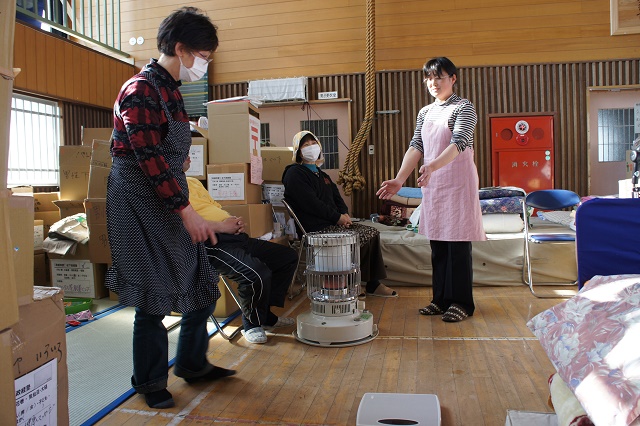
<Notification of those selected for Yonesaki Elementary School temporary housing>
In mid-April, the telephone installed in the Yonesaki Elementary School evacuation shelter rang. I was informed that one person living in the shelter was selected to move into temporary housing.
“Please have them decide until the Xth of April if they will move in. We will be holding an orientation session for those moving into temporary housing on April 27, please join,” is what I was told.
In Rikuzentakata, we had filled out a questionnaire about the different temporary housing locations and our own preference. Our choices were specific temporary housing complexes, any temporary housing within a certain district, and simply anywhere. Naturally, the broader you choice was, the better were your chances.
The temporary housing complex on Yonesaki Elementary School’s sports field was the second one to be built in the city. This means, if you didn’t get into this one, there was no knowing how long you would have to wait until you could move into the next one. I got daily phone calls notifying me that someone was selected to move into temporary housing.
By the time we had received several notifications, the whole gymnasium started buzzing. The phone stopped ringing with notifications about people selected for temporary housing around the 20th of April. The disappointment of those who hadn’t received a call and the anticipation of those who had been chosen to move disturbed the atmosphere inside the evacuation shelter.
At this stage, I hadn’t been chosen to move into temporary housing. I understood the feelings of the people who were disappointed. I myself have young children, who were in elementary school and preschool, and elderly parents, and quickly wanted to move into a temporary housing unit as well.
Eventually, one person’s feelings exploded. They had a parent in need of nursing care. Apparently, they thought that they would be naturally treated as a priority. When a city hall official came to visit the Yonesaki Elementary School evacuation shelter, they stormed over to them ready to have an argument. This city hall official was not the person in charge of the temporary housing issue. Of course, they left without being able to give this person an answer.
For those of us who were left the air hung heavy. I wondered if one of the people in our shelter who had been selected for temporary housing had refused, would this family in need have been able to move? What might have been the reason they hadn’t been treated as a priority? On April 24, I found out why.
<Notice of my family being selected for temporary housing>
“Someone has refused the offer to move. The next family on the list is yours.”
On April 24, I too finally received a call that I was selected to move. After hearing a bit of an explanation, I asked them the following question.
“Why now? Aren’t there welfare families that should be prioritized?”
They replied, “We have a long list of family units that want to be treated as a priority. But if a temporary housing complex is entirely made up of welfare families, how are they going to take care of matters concerning the whole community? We need to think ahead.”
I agree with this. I apologized for my rude question and gladly accepted the chance to move. But when I returned to the shelter, various memories came up, and I simply couldn’t tell the other management officials that I had been chosen to move into temporary housing. But I had been notified on the 24th and the orientation meeting was on the 27th. I couldn’t keep it a secret for very long.
I made up my mind and told them that a notice had come for me at the next management meeting. Some congratulated me, others had worry on their faces. I got various reactions. This was also due to our head of management having been selected for temporary housing at an early stage as well. However, at some point, all of them would be leaving the evacuation shelter. The only problem was if that would be sooner or later.
We decided to recruit new management officials, including the current head official’s successor. The next day, be began reorganizing all of the supplies we had been storing. Keeping the people in mind who were remaining at the evacuation shelter, we decided how much could go and how much should stay. We divided up everyday items like towels and toothbrushes, preserved foods like cup noodles, rice, and cans, and all the other things equally among the households that were moving into temporary housing and the families that were remaining.
<Delays in moving into temporary housing>
The orientation meeting for those moving into temporary housing was on April 27.
The people selected to move as well as the ones who would remain at the evacuation shelters all thought that they would move into the housing units immediately.
But we were told, “Construction is not entirely done, yet. But we are holding this orientation now because we expect the housing units to be completed soon. Unfortunately, the household appliances haven’t arrived, yet, either.” We relayed this information to everyone at the evacuation shelter and asked them to share the space just a little bit longer.
On May 3, I received a message from city hall that construction was completed and we could pick up our keys. Immediately, we went to get our keys and opened up our new rooms. The unit that was assigned to me had two rooms with 8 square meters and one room with 11 square meters. This is where my seven-person family was going to begin a new life.
But the place had no household appliances. Even though we had a place to sleep now, we could not actually live here. When I asked the person in charge, they said they didn’t know when the appliances would come.
Because of the disaster, none of the factories in the entire country were running. The scheduled periodic power outages made factory operations difficult. What made things worse, was that the number of people, whose household appliances had been washed away in the tsunami, was much too high for production to keep up. In the end, all of the people, who had picked up their keys, returned to the evacuation shelter.
It wasn’t only the people chosen to move into temporary housing who were disappointed. The ones left in the gymnasium had thought “with fewer people the workload may be heavier on all of us, but now we have more space to sleep.” And yet, several days passed and we didn’t move. They didn’t get more space. And those, who had planned on moving out, felt guilty.
A week later on May 10, large trucks arrived and brought appliances over appliances.
The last thing to arrive a couple days later were the televisions, but that day, washing machines, rice cookers, and refrigerators were brought into the units and we could actually move in.
<The big cleanup>
At the end of May, more temporary housing units were built on the sports field of the nearby junior high school. Most of the remaining people in the gymnasium evacuation shelter were selected to move into that temporary housing complex. Here too, they couldn’t move in immediately, because the household appliances hadn’t arrived, yet, for the same reason.
Nevertheless, by June 20 all of the evacuees had moved out of the gymnasium. On June 29, all former shelter residents reconvened there and spent all day cleaning it. At the end of June, we returned the gymnasium to Yonesaki Elementary School and the curtain closed on the Yonesaki Elementary School evacuation shelter.
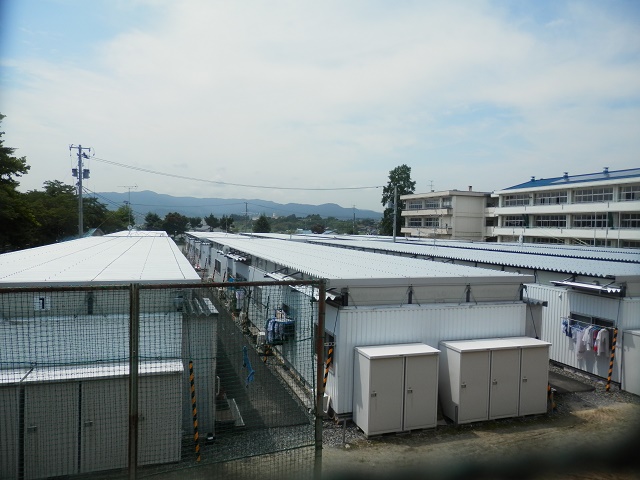
Some closing words
After I posted my last article, I received a lot of feedback. Opinions of approval, negative thoughts, suggestions for improving my writing, complaints about my lack of knowledge. I also read the comments left on social networks as best I could.
I can only write about the occurrences at the Yonesaki Elementary School evacuation shelter, as well as the facts about our activities there. I never intended to create a masterpiece.
I cannot write about other evacuation shelters or the government’s actions. I am sure there were evacuation shelters that were able to solve problems, which were too big for us to handle.
But these are simply things only the people who managed those shelters can talk or write about.
I hope that more stories like mine will be written so that they may serve as manuals in case a disaster like this happens again. And I pray that these manuals will not have to be used forever.
元記事:佐藤一男 東日本大震災、仮設住宅に移るまでに起きたこと (Translated by:Jenny Weiss )
プロフィール

佐藤一男
米崎小学校体育館避難所元運営役員。米崎小学校仮設住宅自治会長桜。ライン311 元副代表http://satokazuo.com/index.html


